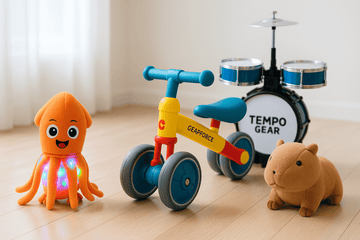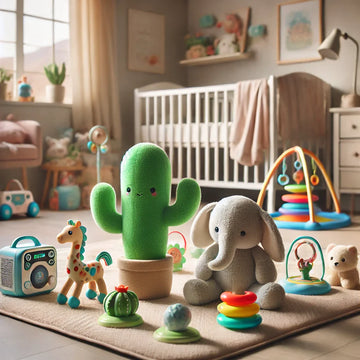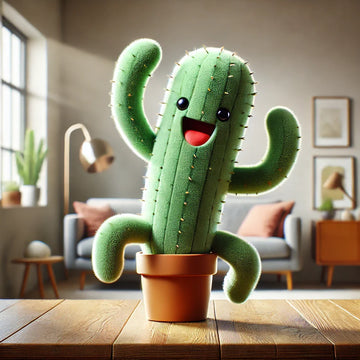Introduction
Why Plush Toys Are Evolving into Developmental Tools
Gone are the days when plush toys were just soft, silent cuddle buddies. In 2025, plush toys have taken a high-tech turn—with talking, singing, dancing, and light-up features designed to captivate and engage kids from infancy through preschool. But here’s the real question: are these flashy features actually good for your child’s development?
As parents become more conscious about the value of toys in their child’s learning journey, there’s growing interest in the benefits of plush interactive toys. These aren’t just gimmicks—they can serve as powerful learning tools, helping to shape language, movement, emotional skills, and sensory awareness.
Expert Interest in Interactive Learning Toys
Experts in early childhood development, speech therapy, and pediatrics are weighing in—and the consensus is clear: when chosen wisely, interactive learning toys can play a meaningful role in your child’s development.
In fact, many therapists now incorporate interactive plush toys into speech sessions and sensory routines, especially for younger children who benefit from repetition, music, and responsive interaction.
This article dives deep into what these toys offer, how they help, and what you should look for when choosing one for your child.
What Are Plush Interactive Toys?
Key Features That Make a Plush Toy ‘Interactive’
Interactive plush toys go beyond soft fur and cute faces. They come to life through built-in technology that allows them to:
-
Talk, mimic, or respond to voices
-
Play music and sing songs
-
Move or dance when activated
-
Light up in sync with sounds or motion
-
Repeat what the child says in a funny voice (mimic mode)
They combine the comforting familiarity of a stuffed animal with the engagement of a smart toy, making them perfect for multi-sensory learning and play.
Examples: Talking, Singing, Dancing, Mimicking Toys
You’ve probably seen or heard of:
-
The Dancing Cactus Toy, which repeats voices and dances to music
-
LeapFrog My Pal Scout, which personalizes learning based on your child’s name and preferences
-
Peek-A-Boo Elephant, which flaps its ears and sings
-
Elmo Live, which interacts with gestures and voice
These toys are wildly popular not just because they’re fun, but because they feel alive—and that’s a big deal for little minds.
Benefits of Plush Interactive Toys for Child Development
Boosting Early Language and Communication
One of the standout benefits of these toys is their ability to support early speech development. Toys that talk or repeat what the child says reinforce vocabulary and sentence structure, while making language feel interactive rather than one-sided.
-
Mimicking toys like the Dancing Cactus are great for toddlers learning to vocalize.
-
Toys that ask questions or give verbal cues help toddlers understand turn-taking in conversation.
-
Repetition through songs or phrases builds familiarity and confidence in language use.
Enhancing Emotional Security and Social Interaction
Kids build emotional bonds with their toys, especially when those toys seem to respond. An interactive plush toy can become a source of comfort and emotional expression, especially for children who are:
-
Shy or socially hesitant
-
Learning to navigate feelings
-
Needing consistency and routine
Interactive features like a toy asking, “How are you feeling today?” or saying, “Let’s play together,” can help children connect emotionally and learn empathy through play.
Encouraging Movement, Motor Skills, and Dance
Toys that wiggle, bounce, or invite your child to dance along encourage physical development, including:
-
Gross motor skills (like jumping, clapping, spinning)
-
Fine motor coordination (pressing buttons, hugging, mimicking movements)
-
Spatial awareness (moving with or around the toy)
Music and movement are proven tools for child development, and these toys make it fun and natural to move with rhythm and purpose.
Sensory Stimulation for Babies and Toddlers
For younger children, especially infants and 1-year-olds, plush interactive toys can be important sensory tools. The combination of:
-
Soft textures for touch
-
Sound and music for auditory stimulation
-
Lights or gentle movement for visual attention
…creates a multi-sensory experience that supports brain development, especially in children with sensory processing differences.
Toys like LeapFrog Scout or musical plush animals from VTech are frequently recommended as developmental toys for 1 year olds and sensory-rich toys for babies under 12 months.
Educational Value of Interactive Toys
Teaching Numbers, ABCs, and Routines Through Play
Interactive plush toys aren’t just fun—they’re also fantastic educational tools. Many toys include built-in lessons that teach:
-
Alphabet and phonics through songs and repetition
-
Counting and numbers in a rhythmic, memorable way
-
Daily routines, such as brushing teeth, bedtime, and mealtime
For instance, toys like LeapFrog Scout and Violet are programmed with songs and phrases that teach your child daily skills while keeping them entertained. This turns everyday learning into a game—and helps reinforce consistency at home.
Cause-and-Effect Learning and Curiosity
Young children thrive on cause-and-effect interactions, and plush interactive toys are masters of that concept. Every time a child presses a button, says a word, or hugs the toy—and it responds—they learn:
-
“When I do X, Y happens”
-
How to predict and understand responses
-
That their actions can create outcomes (empowering!)
This form of learning is critical in early brain development, helping toddlers become more curious, aware, and confident in exploring their environment.
Role of Repetition and Voice Response in Cognitive Growth
While repetition might make parents a little crazy, it’s pure gold for toddlers. Toys that repeat words or phrases, or echo back a child’s voice, provide:
-
Language reinforcement
-
Cognitive pattern recognition
-
A sense of mastery as kids anticipate what’s coming next
Mimicking toys like the Dancing Cactus or Tickle Me Elmo often get used for speech development, especially in early education or therapy settings.
What Experts Say About Developmental Toys
Pediatricians and Educators on Screen-Free Learning
Health and child development experts are increasingly encouraging screen-free alternatives, and plush interactive toys are often seen as a valuable solution.
According to pediatricians:
-
Hands-on, responsive toys help develop sensory and cognitive skills
-
Screen-free interaction promotes attention span and creativity
-
Interactive toys can serve the same engagement purpose as screens—without the drawbacks
Educators agree that when paired with parent interaction, these toys become tools for language building, social play, and emotional growth.
Speech Therapists and Occupational Therapists on Toy Use
Plush interactive toys are routinely used in therapy settings—especially for children with speech delays, autism spectrum traits, or sensory sensitivities.
Therapists report:
-
Toys that repeat a child’s voice can encourage imitation and word formation
-
Interactive plushies help build social routines, like greeting, asking questions, or turn-taking
-
Toys that sing or vibrate can be great for tactile-seeking or auditory-seeking kids
Interactive plush animals strike a rare balance between play, comfort, and purpose, making them a go-to in both homes and clinical environments.
Are These Toys Suitable for All Ages?
Developmental Toys for 1 Year Olds
For 1-year-olds, plush interactive toys offer the perfect mix of sensory input, safety, and entertainment. At this stage, kids are:
-
Learning cause and effect
-
Beginning to mimic sounds and gestures
-
Starting to express emotions and curiosity
The ideal toys for this age include simple, soft plushies that play music, repeat words, or engage with gentle movement—like LeapFrog Violet, Dancing Cactus, or musical stuffed animals with large, easy-to-press buttons.
Sensory Toys for Babies Under 12 Months
For infants, plush toys need to be extra gentle and free of removable small parts. Sensory-focused interactive toys can help stimulate:
-
Hearing (gentle lullabies, heartbeat sounds)
-
Sight (soft, slow lights or high-contrast colors)
-
Touch (varied textures, crinkle fabrics, plush material)
Toys like the Peek-A-Boo Elephant or lullaby plushies with light vibration and soft melodies are wonderful for calming and stimulating babies at the same time.
Interactive Learning Toys for Preschoolers
Preschoolers (ages 3–5) crave stimulation, feedback, and independence. At this stage, more complex plush interactive toys are ideal:
-
Toys that ask questions or respond to verbal commands
-
Characters that encourage learning routines (bedtime, brushing teeth, getting dressed)
-
Plushies that promote roleplay and social imagination
Popular toys for this age group include Scout and Violet, Elmo Live, and even more advanced dancing or singing plushies that promote movement and language use.
The best part? These toys grow with your child, adapting to their changing developmental needs.
Things Parents Should Look for in a Good Interactive Toy
Safety, Materials, and Certifications
Not all interactive plush toys are created equally. When buying one for your child, always check:
-
Soft, non-toxic materials
-
Secure stitching and enclosed battery compartments
-
Safety certifications (look for EN71, ASTM, or other child-safe labels)
-
No choking hazards for babies and toddlers
Trusted brands like LeapFrog, Fisher-Price, and Mr. Cactus Australia offer high-quality options that meet these standards.
Sound Quality, Volume Control, and Repetition Features
Interactive toys are supposed to be fun—not irritating. Look for:
-
Clear audio output (not distorted or too high-pitched)
-
Volume control with a mute or low setting
-
Songs and phrases that loop or repeat without glitches
-
Positive, affirming voice tone
A good toy should enhance play without overwhelming, and volume control is a big factor for daily use in calm environments.
Battery Life, Durability, and Cleaning Tips
Lastly, look for practical features that keep the toy fun (and functional) for months or years:
-
Rechargeable battery options save money and waste
-
Spot-clean or removable electronics for easy cleaning
-
Strong internal wiring that survives frequent squeezes and drops
Durability is key—especially for a toy that talks, sings, and likely goes everywhere your toddler does!
Popular Plush Interactive Toys That Support Development
Dancing Cactus Toy
The Dancing Cactus has gone viral for a reason—it’s fun, interactive, and surprisingly beneficial for speech development. Its mimic mode encourages toddlers to speak and laugh, making it great for early communication.
Why it supports development:
-
Promotes speech mimicry and cause-effect learning
-
Encourages movement and rhythm
-
Offers a sensory-friendly experience with lights, sound, and motion
Trusted versions like the one from Mr. Cactus Australia are built with safe materials, quality sound, and battery protection—perfect for toddlers.
LeapFrog Scout and Violet
These soft, personalizable plush toys are designed to grow with your child, introducing:
-
Your child’s name and favorite things
-
Songs that teach numbers, letters, colors, and routines
-
Emotional phrases like “I love you” or “Let’s play!”
They’re widely recommended by educators and parents for interactive learning in the 1–3 year age group.
VTech Musical Animals
VTech’s musical plush animals combine learning and movement in fun, engaging ways. Options like the VTech Singing Puppy or Musical Moose offer:
-
Buttons for learning ABCs and counting
-
Bright lights and upbeat music
-
Soft, colorful fabric that’s safe for infants and toddlers
They're especially great for sensory stimulation and routine learning.
Elmo and Peek-A-Boo Elephant
Both these toys offer strong emotional and social benefits:
-
Elmo teaches empathy and conversation
-
The elephant engages baby’s visual tracking and curiosity
-
Both provide gentle motion and calming music that help children relax and focus
They’re classics for a reason—and still among the most trusted developmental plush toys today.
FAQs – Plush Toys for Learning and Development
Q1: At what age should I introduce interactive plush toys?
Most are suitable starting around 6 to 12 months, depending on the toy. Always check the label, but many toys offer age-specific features for infants, toddlers, and preschoolers.
Q2: Do these toys actually help with speech?
Yes! Toys that repeat words, sing songs, or ask questions support language development and social engagement, especially in toddlers and children with delayed speech.
Q3: Are they safe for babies who put everything in their mouths?
Choose plush toys designed for infants, with no small parts, non-toxic materials, and sealed battery compartments. Always supervise young babies during play.
Q4: Can I use these toys in a learning routine?
Absolutely. Use them during bedtime wind-down, brushing teeth, or morning songs. Many toys include routines or programmable features for daily structure.
Q5: How long do these toys usually last?
High-quality toys can last months or even years with proper care. Look for brands with durable stitching, long battery life, and positive reviews from parents.
Conclusion: The Playful Path to Growth and Learning
In today’s world, toys aren’t just about entertainment—they’re tools for growth, connection, and early education. The best plush interactive toys blend softness, safety, and smart tech to support your child’s development in the most engaging way possible.
Whether it’s a dancing cactus making your toddler laugh, a Scout that teaches daily routines, or a musical moose introducing ABCs, these toys spark imagination, promote learning, and bring comfort—all at once.
So if you’ve been wondering whether plush interactive toys are worth it—the answer from kids, parents, and experts is a big, giggly YES.




